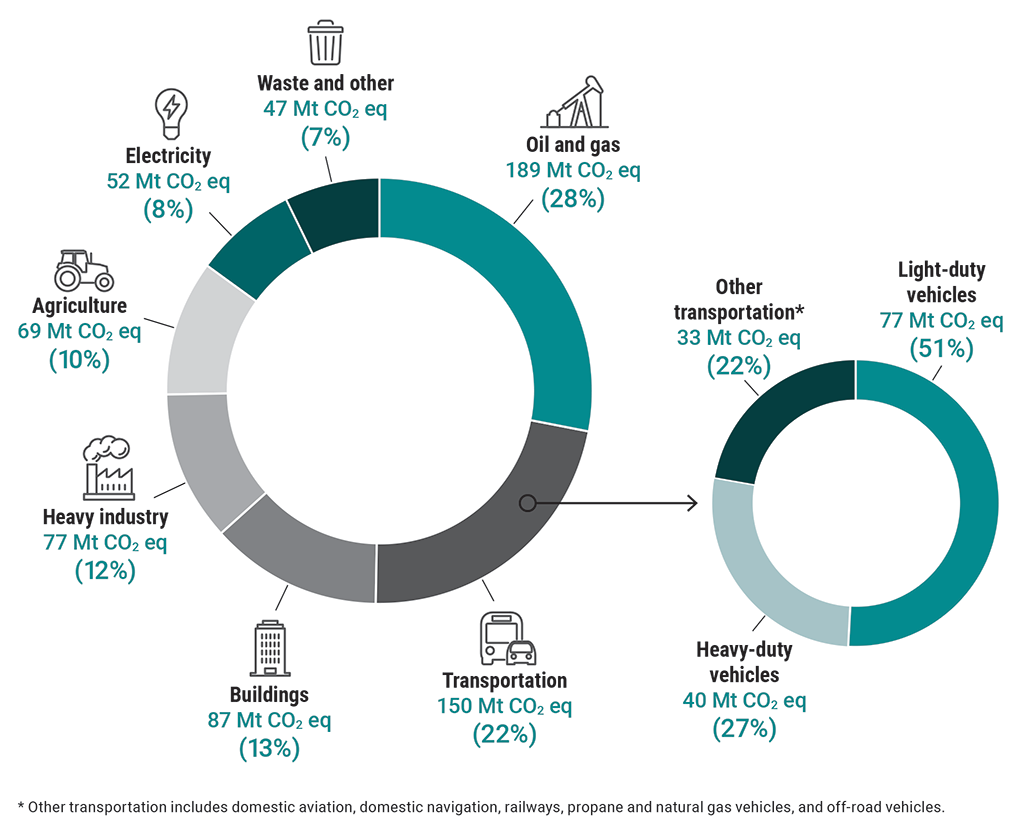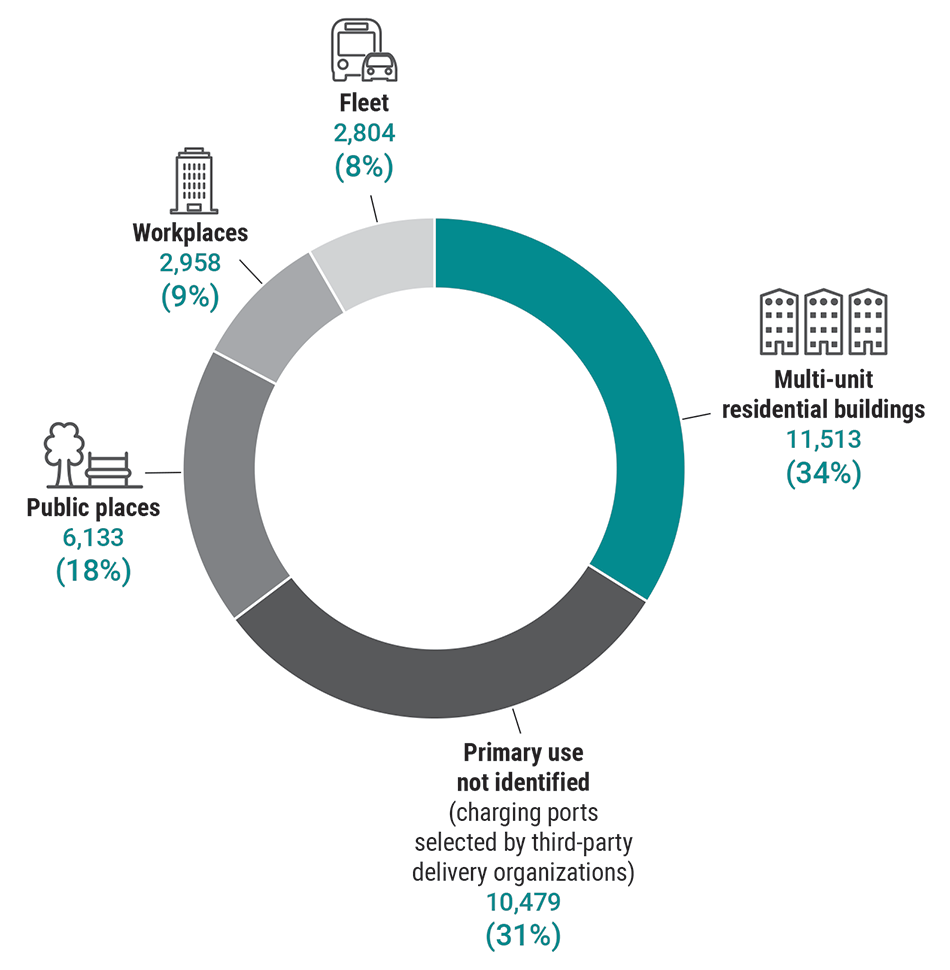2023 Reports 6 to 10 of the Commissioner of the Environment and Sustainable Development to the Parliament of Canada
Report 8—The Zero Emission Vehicle Infrastructure Program—Natural Resources Canada
At a Glance
The federal government has called for all new vehicles sold in Canada to be zero-emission vehicles by 2035, making reliable electric vehicle charging across the country a necessity. Natural Resources Canada is responsible for delivering the Zero Emission Vehicle Infrastructure Program, which funds the deployment of electric vehicle charging infrastructure in Canada. The private sector and other levels of government also have important roles to play.
Overall, Natural Resources Canada has increased the number of charging ports for electric vehicles and is on track for meeting its target of installing 33,500 charging ports by 2026. However, we found flaws in the program’s design. Important aspects were missing from the department’s approach—specifically, the department did not collect and use data to identify gaps and to determine charging locations based on the needs of communities. It also did not establish targets for underserved areas or prioritize locations that are unlikely to be addressed by other organizations, such as other levels of government or the private sector. Many areas of the country still lacked access to public charging stations, and we found that there were limited plans for how or when underserved areas, including rural, remote, and Indigenous communities and lower-income areas, would have access to charging stations.
The program design is meant to promote investments in charging infrastructure and did not factor in measures that would ensure the continued reliability of charging ports beyond being operational at the time of installation. The location of and access to charging stations with operational ports directly affects whether Canadians have the confidence to buy electric vehicles.
A large gap remains between the current number of charging ports and those needed by 2035. Natural Resources Canada is not solely responsible for funding all charging ports, but it needs to coordinate and collaborate with partners, such as provinces, territories, utility companies, municipalities, and the private sector. Together, they need to strategically address the gap in charging infrastructure by leveraging investments and deciding where to locate charging stations to best meet the needs of Canadians.
Key facts and findings
- In Canada’s 2030 Emissions Reduction Plan: Clean Air, Strong Economy, the Government of Canada outlined a mandatory 100% zero‑emission vehicle sales target by 2035 for all new light‑duty vehicles.
- In Canada, 51% of the emissions from the transportation sector come from light‑duty vehicles. The transportation sector as a whole accounted for approximately 22% of greenhouse gas emissions in 2021.
- As of July 2023, 33,887 electric vehicle charging ports had been funded and were either completed or under development. The department was positioned to meet the program’s 33,500‑port target.
- Based on the program’s funding agreements, 87% of the funded charging ports were in Ontario, British Columbia, and Quebec, and 13% were in the other provinces, the Northwest Territories, and Yukon.
- The program also included a shared target between Natural Resources Canada and the Canada Infrastructure Bank for an additional 50,000 charging ports to be installed by March 2029.
Why we did this audit
- Increasing the use of zero‑emission vehicles will help Canada to achieve its climate change targets.
- A key barrier to more Canadians switching to zero‑emission vehicles has been not having enough access to charging stations throughout the country.
- Increasing the availability of and access to charging infrastructure across Canada is important so that drivers can charge their electric vehicles regardless of route and destination.
- All drivers across Canada will be affected by the Government of Canada’s mandate that 100% of new light‑duty vehicle sales be zero‑emission vehicles by 2035.
- The funding and installation of electric vehicle charging infrastructure, and its continued reliability, visibility, and convenience across Canada, are important to ensure access to charging infrastructure, a positive user experience, and public acceptance and motivation to purchase electric vehicles.
Highlights of our recommendations
- Natural Resources Canada should clearly define “underserved areas,” establish specific targets, and use a more strategic approach with criteria that prioritizes electric vehicle charging projects across Canada in areas where others may not invest in charging infrastructure or where there are significant gaps in coverage. This approach could help to ensure that all areas across Canada would benefit from the Zero Emission Vehicle Infrastructure Program’s funding.
- In order to improve transparency and accountability for results, Natural Resources Canada should determine what portion the Zero Emission Vehicle Infrastructure Program will support of the 50,000 zero‑emission vehicle charging port target that the department shares with the Canada Infrastructure Bank.
- Natural Resources Canada should examine how the criteria to assess the Zero Emission Vehicle Infrastructure Program projects or how the program itself could be adjusted so that future funded public electric vehicle charging ports provide users with an increased level of convenience and confidence in the reliability of the program-funded charging stations.
Please see the full report to read our complete findings, analysis, recommendations and the audited organizations’ responses.



The Zero Emission Vehicle Infrastructure Program contributes to the United Nations’ Sustainable Development Goal 9 (Industry, Innovation and Infrastructure) and Goal 13 (Climate Action).
Visit our Sustainable Development page to learn more about sustainable development and the Office of the Auditor General of CanadaOAG.
Exhibit highlights
Greenhouse gas emissions from the transportation sector (in megatonnes of carbon dioxide equivalent, Mt CO2 eq, rounded) compared with other sectors in Canada in 2021

Source: Data from National Inventory Report 1990–2021: Greenhouse Gas Sources and Sinks in Canada, Environment and Climate Change Canada, 2023
Text version
This chart shows the amount of greenhouse gas emissions from the transportation sector compared with other sectors in Canada in 2021. The transportation sector accounted for the second-highest amount of greenhouse gas emissions after the oil and gas sector.
The rounded amounts of greenhouse gas emissions by sector in descending order are as follows:
- Oil and gas accounted for 189 megatonnes of carbon dioxide equivalent, or 28% of Canada’s emissions.
- Transportation accounted for 150 megatonnes of carbon dioxide equivalent, or 22% of Canada’s emissions.
- Buildings accounted for 87 megatonnes of carbon dioxide equivalent, or 13% of Canada’s emissions.
- Heavy industry accounted for 77 megatonnes of carbon dioxide equivalent, or 12% of Canada’s emissions.
- Agriculture accounted for 69 megatonnes of carbon dioxide equivalent, or 10% of Canada’s emissions.
- Electricity accounted for 52 megatonnes of carbon dioxide equivalent, or 8% of Canada’s emissions.
- Waste and other accounted for 47 megatonnes of carbon dioxide equivalent, or 7% of Canada’s emissions.
Of the transportation emissions, light-duty vehicles accounted for 77 megatonnes of carbon dioxide equivalent, or 51% of the sector’s emissions; heavy‑duty vehicles accounted for 40 megatonnes of carbon dioxide equivalent, or 27% of the sector’s emissions; and other transportation accounted for 33 megatonnes of carbon dioxide equivalent, or 22% of the sector’s emissions. Other transportation includes domestic aviation, domestic navigation, railways, propane and natural gas vehicles, and off-road vehicles.
Charging stations funded and installed under the Zero Emission Vehicle Infrastructure Program have level 2 and level 3 ports
 |
|||
|
Alternating current (AC) provides electricity to a vehicle via level 1 and level 2 charging ports |
Direct current (DC) charging ports provide electricity to a vehicle at a fast rate |
||
|---|---|---|---|
|
Level 1 |
Level 2 |
Level 3 or direct current fast charger |
|
|
Input voltage and current |
120 volt AC 12 to 16 amperes |
208 to 240 volt AC 15 to 80 amperes |
480 to 920 volt DC 40 to 500 amperes |
|
Charge power |
1.4 to 1.9 kilowatts |
3.1 to 19.2 kilowatts |
20 to 350 kilowatts |
|
Time to chargeNote * |
8 to 30 hours |
4 to 10 hours |
10 to 30 minutes |
|
Typical uses |
Home charging |
Charging at businesses, multi‑unit residential buildings, and public spaces |
Charging at dedicated stations, in public spaces, in commercial fleet areas, and along highways |
|
Zero Emission Vehicle Infrastructure Program |
|||
Source: Data from Natural Resources Canada
Zero-emission vehicle fleet size and populations in Canada in 2021

Note: Data for British Columbia includes the Northwest Territories, Nunavut, and Yukon, which have very low levels of electric vehicle sales.
Sources: Data from Statistics Canada and Transport Canada
Text version
This chart compares the zero‑emission vehicle fleet sizes and population sizes in British Columbia and the territories, Ontario, Quebec, and other provinces in 2021. The data for British Columbia includes the Northwest Territories, Nunavut, and Yukon, which have very low levels of electric vehicle sales.
The zero-emission vehicle fleet sizes by region in descending order were as follows:
- In Quebec, there were 110,574 zero‑emission vehicles, or 45% of Canada’s total number of zero‑emission vehicles.
- In British Columbia and the territories, there were 65,568 zero‑emission vehicles, or 26% of Canada’s total.
- In Ontario, there were 60,325 zero‑emission vehicles, or 24% of Canada’s total.
- In the other provinces, there were 12,114 zero‑emission vehicles, or 5% of Canada’s total.
However, the order changes when looking at population size:
- Although Quebec had the largest fleet size, it had the third-largest population—that is, 8.6 million people, or 22% of Canada’s population.
- Although British Columbia and the territories had the second-largest fleet size, they had the smallest population—that is, 5.4 million people, or 14% of Canada’s population.
- Although Ontario had the third-largest fleet size, it had the largest population—that is, 14.9 million people, or 39% of Canada’s population.
- Although the other provinces had the smallest fleet size, they had the second-largest population—that is, 9.5 million people, or 25% of Canada’s population.
The largest share of the charging ports selected for Zero Emission Vehicle Infrastructure Program funding (in operation and in progress) were serving multi‑unit residential buildings as of July 2023

Note: Public places include street parking and parking areas at service stations, retail stores, restaurants, arenas, libraries, and medical offices.
Source: Data from Natural Resources Canada
Text version
This chart shows the different types of charging ports funded through the Zero Emission Vehicle Infrastructure Program.
The largest share of the funding was for charging ports at multi‑unit residential buildings. The program funded 11,513 ports, or 34% of the total ports funded.
For 10,479 ports, or 31% of the ports funded, the ports’ primary use was not identified. (These were the charging ports selected by third-party delivery organizations.)
The program funded 6,133 ports in public places, or 18% of the total ports funded. Public places include street parking and parking areas at service stations, retail stores, restaurants, arenas, libraries, and medical offices.
The program funded 2,958 ports in workplaces, or 9% of the total ports funded.
The program funded 2,804 ports in for fleets, or 8% of the total ports funded.
Infographic

Text version
Zero-Emission Vehicles and Charging Infrastructure
The Government of Canada has committed to reducing greenhouse gas emissions by 40% to 45% below 2005 levels by 2030. Zero‑emission vehicles will be an essential part of achieving this goal.
Twenty-two percent of greenhouse gas emissions are produced from transportation. Greenhouse gas emissions are also produced from oil and gas (28%), buildings (13%), heavy industry (12%), agriculture (10%), electricity (8%), and waste and other sources (7%). Of the greenhouse gas emissions produced from transportation, 51% are from light‑duty vehicles, 27% are from heavy‑duty vehicles, and 22% are from other vehicles. (The source of this data is the National Inventory Report 1990–2021: Greenhouse Gas Sources and Sinks in Canada, Environment and Climate Change Canada, 2023.)
As part of the solution, the federal government requires all new light‑duty vehicles sold in Canada to be zero emission by 2035.
Zero-emission vehicles include plug‑in hybrid electric vehicles, whose sources of energy are gas and electricity; battery electric vehicles, whose source of energy is electricity; and hydrogen fuel cell electric vehicles, whose source of energy is hydrogen. Plug‑in hybrid electric vehicles have low emissions, while battery electric and hydrogen fuel cell electric vehicles have no emissions.
Vehicles not to be sold after 2035 include internal combustion vehicles, whose source of energy is gas, and conventional hybrid vehicles, whose sources of energy are gas and electricity. Both types of vehicles have high emissions.
Two audits
Two audits were conducted: The Zero Emission Vehicle Infrastructure Program and Departmental Progress in Implementing Sustainable Development Strategies—Zero-Emission Vehicles.
The Zero Emission Vehicle Infrastructure Program
This audit looked at increasing Canadians’ access to reliable electric vehicle charging.
Natural Resources Canada is on track to meet its target of 33,500 charging port installations by 2026. There are 6,654 operational ports, 27,233 ports under construction, 33,500 ports in the program target, and 33,887 funded ports.
There are 3 types of electric vehicle charging ports: Level 1, Level 2, and Level 3. Chargers funded by the program are those with Level 2 and Level 3 charging ports. Level 1 charging ports are used in private homes. Level 2 charging ports are used at residential buildings, in public places, and at workplaces. Level 3 charging ports are used at dedicated stations, in public spaces, in commercial fleets, and along highways.
Charging stations are located at workplaces (such as an office building), in public places (such as a parking garage), at residential buildings (such as an apartment building), and at fleet operations (such as a taxi stand).
The department’s approach did not include how or when underserved areas, such as remote and Indigenous communities, would have access to charging stations.
Departmental Progress in Implementing Sustainable Development Strategies—Zero‑Emission Vehicles
This audit assessed whether selected federal organizations bought enough zero‑emission vehicles to meet the target under the Greening Government goal.
The following administrative fleets were audited: National Defence (6,465 vehicles), Parks Canada (1,665 vehicles), Fisheries and Oceans Canada (1,337 vehicles), and the Canada Border Services Agency (1,113 vehicles).
As of March 2022, 3% of vehicles were zero emission across the entire government fleet, while 7% were conventional hybrid. The zero‑emission vehicle target is 80% of the fleet.
None of the 4 organizations were strategic in their approaches to decarbonizing their fleets to meet the government’s target. Buying conventional hybrid vehicles will not lead to meeting the 80% target and will not reduce the level of emissions as much as zero-emission vehicles.
Barriers include the lack of available zero‑emission vehicles, the lack of specialized zero‑emission vehicles, and an unavailable charging infrastructure.
Increasing the number of zero-emission vehicles in the federal administrative fleet not only contributes to reducing emissions, but also demonstrates leadership toward the achievement of the United Nations’ Sustainable Development Goals and the fight against climate change.
The move toward electric vehicles is only one piece of the puzzle toward a zero‑emission future.
Related information
Entities
Tabling date
- 7 November 2023
Related audits
- 2023 Reports of the Commissioner of the Environment and Sustainable Development to the Parliament of Canada
Report 7—Departmental Progress in Implementing Sustainable Development Strategies—Zero-Emission Vehicles - 2022 Reports of the Commissioner of the Environment and Sustainable Development to the Parliament of Canada
Report 3—Hydrogen’s Potential to Reduce Greenhouse Gas Emissions - 2022 Reports of the Commissioner of the Environment and Sustainable Development to the Parliament of Canada
Report 2—Greening Government Strategy - 2022 Reports of the Commissioner of the Environment and Sustainable Development to the Parliament of Canada
Report 1—Just Transition to a Low-Carbon Economy
